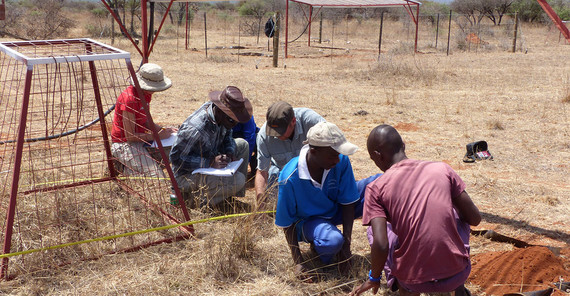Plant growth is a fundamental component of the global carbon cycle. That is because plant photosynthesis is the main way carbon dioxide enters ecosystems, where plants store it as biomass and animals consume it. Because grasslands and shrublands cover roughly 50 percent of the Earth’s surface, they play a large role in balancing and facilitating carbon uptake and sequestration globally. These ecosystems lose their ability to recover over time under prolonged dry conditions. The international research team could show that losses in biomass productivity were more than twice as high after four years of continued extreme drought when compared to losses from droughts of moderate intensity.
“We show that – when combined – extreme, multi-year droughts have even more profound effects than a single year of extreme drought or multi-year moderate droughts,” said Melinda Smith, Biology Professor at the Colorado State University, who led the study with Timothy Ohlert,a postdoctoral researcher from her lab. “The Dust Bowl is a good example of this,” she continued. “Although it spanned nearly a decade it was only when there were consecutive extremely dry years that those effects, such as soil erosion and dust storms, occurred. Now with our changing climate, Dust Bowl-type droughts are expected to occur more frequently.” Dust Bowl refers to a drought disaster in the USA in the 1930s, when heat and water shortages, combined with unsustainable farming practices, led to devastating dust storms.
The interaction between extremity and duration in drought conditions has rarely been systematically studied using experiments. Smith designed and led the International Drought Experiment with more than 170 researchers around the world. For the project, they built structures that reduced each rainfall event by a target amount over a four-year period in grassland and shrubland ecosystems across six continents.
By simulating once-in a century extreme drought conditions, the international research team was able to study both the long- and short-term effects on grasslands and shrublands. Differences in rainfall patterns, soil properties and vegetation across continents meant that each site experienced a distinct mix of moderate and extreme drought years – providing unique experimental conditions that informed this study.
Anja Linstädter, plant ecology professor at the University of Potsdam, contributed to this international network through a drought experiment in southern Africa. “We were surprised to find that even in these dryland ecosystems, which are generally well adapted to low and variable rainfall, extreme drought had a particularly strong negative impact on forage production – even stronger than in many other ecosystems. This shows that we still have much to learn about how resilient ecosystems really are to extreme drought events.” Ildikó Orbán, postdoctoral researcher in Potsdam, adds: “Understanding these responses is crucial, as climate change is expected to make extreme and prolonged droughts increasingly common in most regions of the world.”
Link to Publication: Timothy Ohlert et al., Drought intensity and duration interact to magnify losses in primary productivity. Science 390, 284-289 (2025).
https://www.science.org/doi/10.1126/science.ads8144
Contact:
Prof. Dr. Anja Linstädter, Institute of Biochemistry and Biology
Phone: +49 331 977-1920
Email: anja.linstaedteruuni-potsdampde
Media Information 21-10-2025 / Nr. 094
Dr. Stefanie Mikulla
(based on a press release by Colorado State University)


